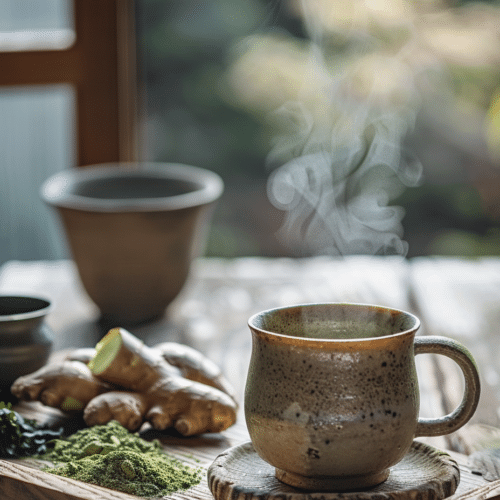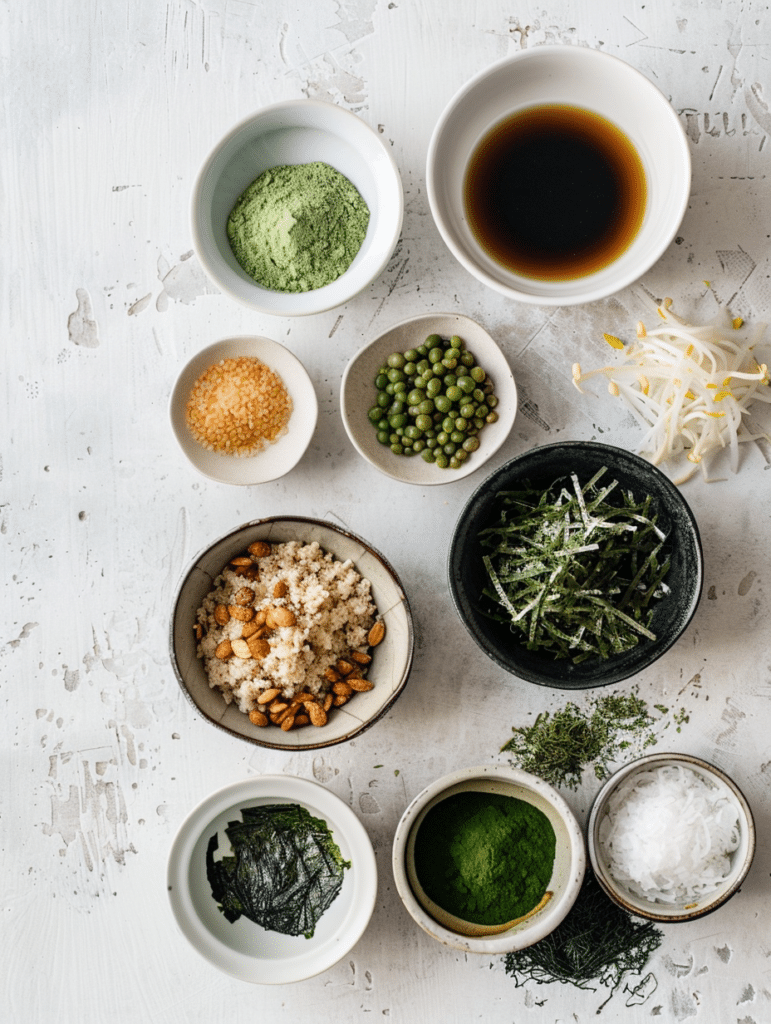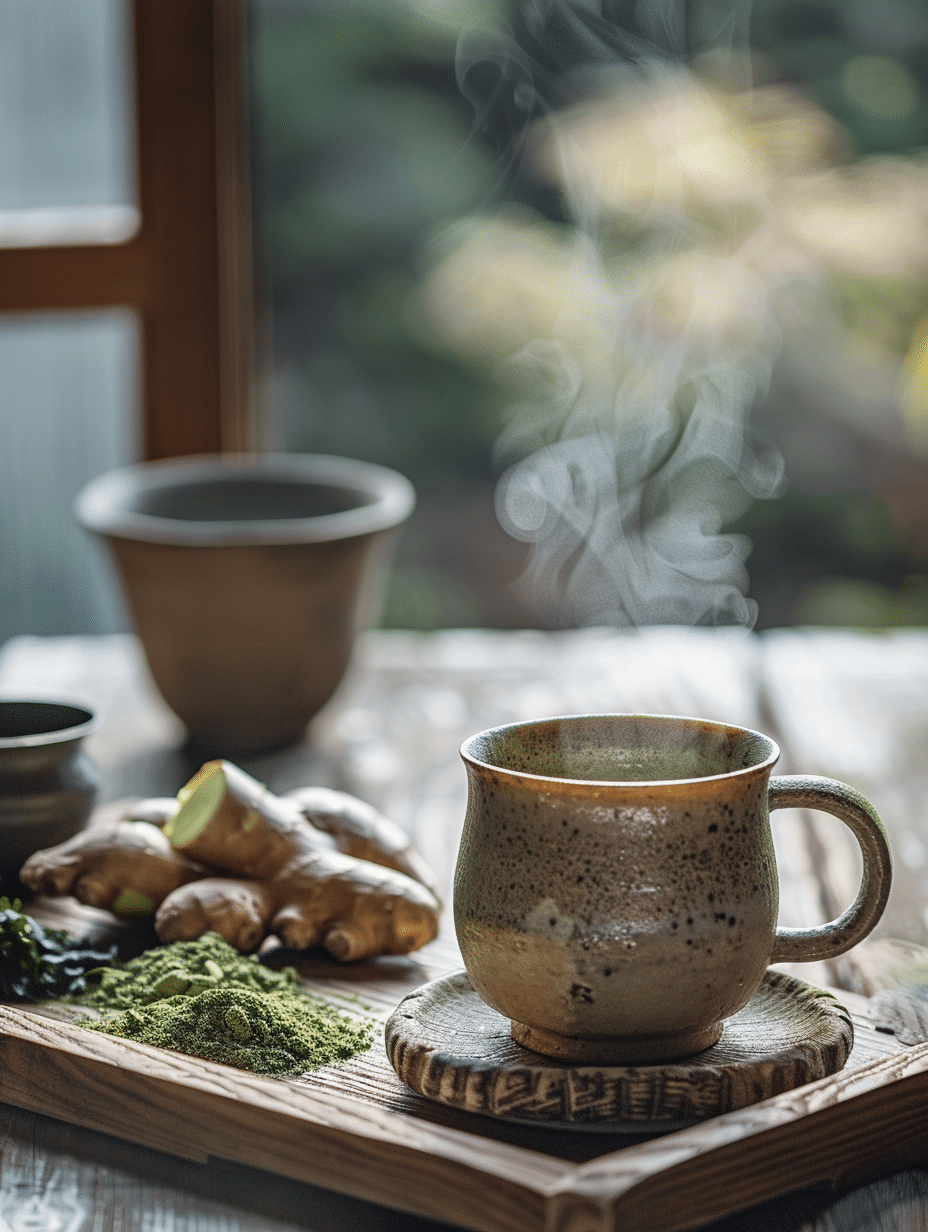Introduction
Japanese Maounjaro ingredients are becoming a hot topic in wellness and weight loss circles. Rooted in ancient Japanese herbal practices, these ingredients are praised for their fat-burning, metabolism-boosting, and appetite-curbing effects—without relying on synthetic drugs. In this article, we’ll explore the origins, benefits, recipes, and hacks for using these natural powerhouses. Whether you’re curious about replacing prescription weight-loss options like Ozempic or simply looking for a better way to eat clean, you’re in the right place.
Check out this hearty Baked Beans Recipe – rich in plant-based proteins, it’s a perfect Maounjaro-compatible side dish.
Table of Contents

Japanese Maounjaro Ingredients: The Best 8 Natural Fat Burners
Equipment
- Bamboo whisk
- Ceramic mug
- Measuring spoons
Ingredients
- 1 tsp matcha powder
- 1 tsp grated ginger
- 1/2 tsp konjac root powder
- 1/4 tsp sea kelp flakes
- 1 tsp yuzu juice
- 1.5 cups hot water not boiling
Instructions
- Heat water until just below boiling.
- Whisk matcha in mug until smooth.
- Add konjac powder slowly while stirring.
- Mix in grated ginger, kelp, and yuzu juice. Let steep 2–3 minutes.
- Strain and serve warm.
Video
Notes
Nutrition
PART 1: Origins of Japanese Maounjaro and Its Cultural Roots
The Legacy of Japanese Herbal Wellness
The foundation of Japanese Maounjaro ingredients lies deeply in Kampo medicine—a centuries-old Japanese system that evolved from traditional Chinese herbal practices. Unlike Western weight-loss trends that rely on synthetic compounds, Kampo emphasizes natural healing through plants, minerals, and food-based treatments. This natural path aligns perfectly with the philosophy behind Japanese Maounjaro.
Used for treating fatigue, inflammation, and gut imbalance, these herbal practices are more than just remedies—they are lifestyle elements. For generations, Japanese healers have relied on specific ingredients found in nature, many of which now define the Japanese Maounjaro ingredient list used in modern wellness recipes.
What Does “Maounjaro” Really Mean in Japanese Culture?
Although the term “Maounjaro” is more widely recognized in Western wellness circles today, its roots echo the Japanese principle of Ishoku Dōgen (医食同源), or “medicine and food from the same source.” This principle guides the use of food as preventive medicine, especially through ingredients that are anti-inflammatory, detoxifying, and nourishing.
In Japanese cuisine and herbal traditions, ingredients like konjac root, natto (fermented soybeans), matcha, kelp, and yuzu are more than just flavorful elements—they are tools for health. Many of these components are central to the Japanese Maounjaro ingredients that people now seek for weight management and overall wellness.
Even in ancient Buddhist temples, monks practiced long periods of fasting using nutrient-dense broths and herbal teas to stay alert and balanced. These early forms of Maounjaro-like blends were made with real, whole ingredients meant to nourish the body naturally.
So, when we talk about Japanese Maounjaro ingredients today, we’re not referring to a single product. We’re talking about a philosophy—a way of eating and healing that blends nature, tradition, and intentional nutrition into every sip and bite.

PART 2: Understanding the Core Japanese Maounjaro Ingredients
Key Herbs Used in Traditional Maounjaro Blends
The effectiveness of Japanese Maounjaro ingredients lies in their synergy. Each herb isn’t just chosen for individual benefit but for how it complements others to promote metabolism, energy, and detoxification. These ingredients aren’t new inventions—they’ve been used in Japanese healing traditions for centuries.
Here are the most essential Japanese Maounjaro ingredients used in both traditional and modern blends:
| Ingredient | Japanese Name | Function |
|---|---|---|
| Konjac Root | Konnyaku | Rich in glucomannan; suppresses appetite |
| Matcha | 抹茶 (Matcha) | High in EGCG; boosts metabolism and focus |
| Natto | 納豆 (Nattō) | Fermented soy; supports gut health and hormones |
| Yuzu Peel | 柚子 (Yuzu) | Antioxidant-rich; supports digestion |
| Shiso Leaf | 紫蘇 (Shiso) | Anti-inflammatory and detoxifying |
| Umeboshi Plum | 梅干し (Umeboshi) | Aids digestion, balances acidity |
| Ginger Root | 生姜 (Shōga) | Enhances circulation and metabolism |
| Sea Kelp | 昆布 (Kombu) | Rich in iodine; regulates thyroid metabolism |
These ingredients form the heart of Japanese Maounjaro formulas, especially in powdered tea blends or infusions. Each one plays a unique role, but when combined, they create a multi-layered effect on appetite control, energy, and gut support.
Nutritional Value and Wellness Benefits of Each Core Ingredient
Let’s explore how these Japanese Maounjaro ingredients support wellness beyond just weight loss:
- Konjac Root: Contains glucomannan, a soluble fiber that expands in your stomach and helps you feel full. It’s often used in diet noodles or drink powders for appetite suppression.
- Matcha Green Tea: A staple of Japanese culture, matcha delivers antioxidants (especially EGCG) that increase fat oxidation, improve alertness, and detox the liver naturally.
- Natto: This fermented soybean is packed with Vitamin K2 and probiotics, which are essential for bone health, hormonal balance, and gut microbiota.
- Yuzu: The aromatic citrus used in seasoning and teas supports digestion and enhances flavor without added sugar or salt.
- Shiso Leaf: Known for its cleansing properties, shiso helps reduce inflammation, supports liver function, and adds a cooling herbaceous flavor to dishes.
- Umeboshi Plum: Known for its sour punch, it detoxifies the liver and balances stomach acidity, often used in fasting regimens or as a morning tonic.
- Ginger: Used globally, but especially revered in Japan for improving circulation, reducing bloating, and speeding up metabolism.
- Sea Kelp (Kombu): One of the most underrated Japanese Maounjaro ingredients, kombu contains iodine for healthy thyroid function, helping regulate body weight and temperature.
Together, these ingredients represent more than a diet trend—they embody centuries of nutritional intelligence rooted in balance and natural wellness. They’re easy to integrate into daily routines through teas, soups, seasoning powders, or even capsules.
Discover great ideas like the Authentic Mai Tai Recipe for learning how to mix powerful natural elements into tasty drinks.

PART 3: How to Make Japanese Maounjaro at Home
Step-by-Step Recipe Guide Using Authentic Ingredients
Creating your own version of Japanese Maounjaro ingredients at home is easier than you think. By combining key traditional elements like konjac root, matcha, ginger, and sea kelp, you can craft a powerful blend that supports energy, detoxification, and appetite control—without relying on synthetic compounds.
Here’s a basic recipe for a Japanese Maounjaro wellness tea blend that you can consume daily:
DIY Japanese Maounjaro Tea Blend Recipe
| Ingredient | Quantity | Purpose |
|---|---|---|
| Matcha Powder | 1 tsp | Boosts metabolism and energy |
| Konjac Powder | ½ tsp | Curbs appetite and aids digestion |
| Grated Ginger (fresh) | 1 tsp | Reduces bloating, improves circulation |
| Sea Kelp Flakes | ¼ tsp | Adds iodine, supports thyroid health |
| Yuzu Zest or Juice | 1 tsp | Enhances flavor, supports gut function |
| Lemon Juice (optional) | 1 tsp | Extra vitamin C and detoxification |
| Hot Water | 1½ cups | For infusion |
Preparation Instructions:
- Heat the water until just before boiling.
- In a large mug, whisk matcha powder using a bamboo whisk (or small electric frother).
- Add konjac powder slowly, stirring constantly to avoid clumps.
- Stir in grated ginger, yuzu zest, and kelp flakes.
- Let the mixture steep for 2–3 minutes.
- Add optional lemon juice for an extra detox boost.
This tea should be consumed once in the morning before breakfast or 30 minutes before lunch. It helps reduce cravings, energizes the body, and sets your digestive system in motion.
Looking for a chilled version? Simply let the brew cool and pour it over ice for a refreshing summer Maounjaro tonic.
Recommended Kitchen Tools and Techniques for Optimal Potency
To maximize the health impact of your Japanese Maounjaro ingredients, how you prepare them is just as important as what you use:
- Bamboo Whisk (Chasen): Helps aerate and evenly mix matcha powder.
- Glass or Ceramic Mug: Avoid metals that may react with antioxidants.
- Microplane Zester: Perfect for extracting essential oils from yuzu and ginger.
- Digital Kitchen Scale: To measure exact amounts of powder ingredients like konjac or kelp.
- Fine Mesh Strainer: Useful if you want to strain fibrous bits for a smoother texture.
Don’t forget, freshness matters. Always store your powdered Japanese Maounjaro ingredients in airtight, dark glass containers away from heat and moisture. This protects their potency and extends shelf life.
Looking for inspiration? Try this Fruit Dip Recipe as a low-sugar snack that complements a Maounjaro-focused lifestyle.
PART 4: Natural Alternatives to Japanese Maounjaro
Herbal Blends with Similar Properties
If you’re interested in the effects of Japanese Maounjaro ingredients but want more flexibility or local availability, there are several natural alternatives that mimic their benefits. These blends can be homemade or store-bought and often include global superfoods with similar fat-burning, appetite-suppressing, and energy-boosting effects.
Top Natural Alternatives
| Alternative Blend | Key Ingredients | How It Compares |
|---|---|---|
| Ayurvedic Weight Loss Tea | Triphala, ginger, turmeric, fennel | Boosts digestion, detox, reduces bloating |
| Korean Ginseng Tonics | Red ginseng, honey, licorice root | Enhances energy, sharpens focus |
| Western Detox Infusion | Dandelion, lemon peel, peppermint | Mild diuretic, supports liver detox |
| Chinese Pu-erh Tea Blends | Fermented black tea, goji berries, cinnamon | Suppresses appetite, improves fat burn |
| Raw Apple Cider Vinegar Mix | ACV, cayenne, honey, water | Regulates blood sugar, boosts metabolism |
Each of these formulas can serve as a substitute or supplement to Japanese Maounjaro ingredients if you’re looking to diversify your approach while staying natural and drug-free.
One key advantage of these blends is accessibility—most of their components can be found in Western grocery stores or online. However, the philosophy remains the same: natural, functional ingredients that support your body’s own rhythm without overstimulation or harsh chemicals.
Comparing Japanese Maounjaro to Western Alternatives like Ozempic
Ozempic (semaglutide) is a synthetic GLP-1 receptor agonist used for type 2 diabetes and weight loss. While effective, it comes with significant side effects such as nausea, constipation, and long-term metabolic dependency. That’s where Japanese Maounjaro ingredients shine.
| Feature | Japanese Maounjaro | Ozempic |
|---|---|---|
| Source | Natural herbs and roots | Synthetic pharmaceutical |
| Appetite Control | Gentle, fiber-based (e.g., konjac) | Artificial GLP-1 simulation |
| Side Effects | Minimal, food-based | Nausea, cramps, possible vomiting |
| Accessibility | Available as teas, powders | Prescription-only in most regions |
| Long-term Use | Sustainable and safe | Can lead to resistance and cost |
What truly separates Japanese Maounjaro ingredients from their pharmaceutical counterparts is their compatibility with food. Rather than forcing the body to behave differently, these herbs gently guide your metabolism, making it easier to lose fat without crashing your energy levels.
Plus, they align with holistic nutrition practices like intuitive eating, gut health optimization, and hormonal balance.
PART 5: Daily Meal Ideas with Japanese Maounjaro Recipes
Sample One-Day Menu Using Maounjaro-Inspired Dishes
Integrating Japanese Maounjaro ingredients into your daily meals doesn’t require a drastic lifestyle overhaul. In fact, many of these herbs and foods are already used in traditional Japanese diets—just with mindful combinations and timing to support weight loss, energy, and digestive health.
Here’s a simple, full-day Maounjaro-inspired meal plan using only whole, natural ingredients aligned with this wellness approach:
Breakfast: Matcha & Konjac Green Smoothie
Start your day with an energizing, metabolism-boosting drink.
Ingredients:
- 1 tsp matcha powder
- ½ tsp konjac root powder
- 1 banana
- 1 cup unsweetened almond milk
- ½ tsp yuzu zest
- 1 tsp chia seeds
Blend until smooth. This smoothie curbs hunger and enhances focus with no caffeine crash.
Mid-Morning Snack: Umeboshi Rice Ball (Onigiri)
A classic Japanese snack made with fermented plum that supports digestion and reduces bloating.
Ingredients:
- ½ cup cooked short-grain rice
- 1 small umeboshi plum
- Sprinkle of toasted sesame seeds
- 1 sheet of nori
Form the rice into a triangle or ball with the umeboshi in the center. Wrap in nori and enjoy.
Lunch: Sea Kelp & Shiso Leaf Miso Soup
Light, warming, and packed with anti-inflammatory compounds.
Ingredients:
- 2 cups dashi broth (kelp base)
- 1 tbsp white miso paste
- A handful of chopped shiso leaves
- ¼ cup cubed tofu
- A few strips of rehydrated kombu (kelp)
- Scallions, optional
Simmer the ingredients for 5–10 minutes. Avoid boiling the miso to preserve probiotics.
Afternoon Pick-Me-Up: Yuzu Ginger Detox Tea
A simple tonic that boosts circulation and re-energizes without sugar.
Ingredients:
- 1 cup hot water
- 1 tsp grated ginger
- 1 tsp yuzu juice
- Optional: a touch of raw honey
Sip slowly while taking a walk or doing light stretches.
Dinner: Natto & Brown Rice Bowl
This probiotic-rich dinner supports gut health and hormone balance.
Ingredients:
- 1/2 cup cooked brown rice
- 1 pack natto (fermented soybeans)
- 1 tsp soy sauce
- Chopped green onions
- 1 poached egg (optional)
Mix natto thoroughly before serving—it becomes frothy, which improves flavor and texture.
Tips for Integrating Maounjaro into Your Routine
- Eat Maounjaro ingredients earlier in the day for better energy and reduced cravings.
- Pair with warm water or broth to help absorption.
- Avoid added sugars or processed foods that counteract the benefits.
- Track how your body responds—some ingredients like konjac may cause bloating if overused.
This type of menu showcases how Japanese Maounjaro ingredients can become a seamless part of your everyday routine—not just a supplement, but a lifestyle.
Don’t miss our Baked Beans Recipe for a hearty plant-based dish that complements Japanese Maounjaro meal plans.
PART 6: Lifestyle and Diet Hacks to Maximize Results
Japanese Food Rituals to Amplify the Effect of Maounjaro
To get the most from Japanese Maounjaro ingredients, it’s not just about what you eat—but how and when you eat. Traditional Japanese wellness teaches that food is a ritual, not a rush. Here are simple practices rooted in Japanese culture that elevate the power of Maounjaro-inspired meals:
1. Practice Hara Hachi Bu (Eat Until 80% Full)
This ancient Okinawan philosophy encourages mindful eating. By stopping at 80% fullness, you reduce overeating, giving Maounjaro ingredients like konjac root space to expand in the stomach and suppress further cravings.
2. Sip Herbal Teas Between Meals
Instead of snacking, many Japanese wellness followers sip warm teas made with Maounjaro ingredients like matcha, yuzu peel, and ginger. This helps curb unnecessary hunger while boosting digestion.
3. Use Smaller Plates and Bowls
Portion control becomes natural when food is served in smaller dishes—a visual cue that helps regulate intake, especially with appetite-reducing ingredients.
4. Eat Slowly and Without Distractions
Chewing thoroughly improves nutrient absorption, especially when consuming fibrous Maounjaro foods like natto or shiso. It also gives your body time to recognize fullness signals.
When and How to Take Maounjaro Blends for Best Absorption
Timing is critical when using Japanese Maounjaro ingredients for fat-burning or energy-boosting purposes. Here’s how to time your consumption for optimal results:
| Time of Day | Ingredient Focus | Purpose |
|---|---|---|
| Morning (fasted) | Matcha + Ginger + Yuzu Tea | Boost metabolism, cleanse liver, sharpen focus |
| Pre-Lunch | Konjac Drink or Soup Base | Suppress appetite, stabilize blood sugar |
| Afternoon (slump) | Shiso Leaf Tea or Kombu Miso Broth | Sustain energy, fight inflammation |
| Evening | Umeboshi or Kelp Soup | Aid digestion, promote detoxification |
Smart Hacks for Easy Integration
- Pre-mix powdered Maounjaro blends for travel or office use.
- Replace coffee with warm Maounjaro teas to avoid energy crashes.
- Batch-cook broth-based dishes with kelp and shiso on weekends.
- Freeze grated ginger and yuzu zest into ice cube trays for instant use.
These simple rituals and timing adjustments can drastically improve the efficacy of Japanese Maounjaro ingredients, helping you build habits that promote sustained wellness.
Discover great ideas like the Authentic Mai Tai Recipe to learn how to blend natural elements into flavorful drinks—minus the sugar.
PART 7: Safety and Side Effects of Japanese Maounjaro Ingredients
Scientific Backing and Traditional Wisdom
While Japanese Maounjaro ingredients are rooted in natural wellness and cultural heritage, it’s still essential to understand their safety profile—especially when combining several herbs and roots for daily use.
The good news? Most of these ingredients—such as konjac root, matcha, natto, yuzu, and shiso—have been consumed safely in Japan for generations. They’re recognized not just for their therapeutic properties but also for their everyday culinary use.
In modern studies, many components of the Japanese Maounjaro ingredient list have been evaluated for safety:
- Konjac root (glucomannan): Generally safe in small doses but may cause bloating or choking if not consumed with sufficient water.
- Matcha: High in antioxidants, but excessive intake (over 5 cups/day) may lead to caffeine-related symptoms like insomnia or jitteriness.
- Natto: Contains high vitamin K2—great for bone health but may interfere with blood-thinners like warfarin.
- Sea kelp: Rich in iodine; overconsumption could affect thyroid function if taken in large daily quantities.
In summary, Japanese Maounjaro ingredients are safe for most healthy adults when consumed in moderate amounts as part of a balanced diet.
Who Should Avoid Japanese Maounjaro Ingredients?
While these ingredients offer numerous benefits, certain individuals may want to limit or avoid them:
| Condition | Ingredient(s) to Avoid | Reason |
|---|---|---|
| Thyroid disorders | Kombu (kelp), excess seaweed | High iodine can disrupt thyroid hormone levels |
| Blood-thinner medication | Natto | Contains Vitamin K2, may interact with meds |
| Pregnancy or breastfeeding | High caffeine matcha, excess yuzu | May affect fetal development or milk supply |
| Digestive sensitivity | Konjac root, large doses of fiber-rich teas | Can cause bloating, cramps, or gas |
Important Guidelines for Safe Use:
- Always start with small amounts and observe how your body reacts.
- Drink plenty of water with fiber-heavy Maounjaro blends (like konjac).
- Consult your doctor if you’re on thyroid or anticoagulant medication.
- Avoid stacking multiple stimulant ingredients (e.g., matcha with green coffee).
In general, the safety of Japanese Maounjaro ingredients is high because they are food-based, not synthetically engineered. But mindful usage is key to getting benefits without discomfort.
PART 8: Where to Find Authentic Japanese Maounjaro Ingredients
Trusted Local and Online Sources
As the popularity of Japanese Maounjaro ingredients rises, so does the risk of counterfeit or diluted products. Whether you’re shopping online or at a local Asian market, knowing where to buy authentic ingredients is key for safety, potency, and effectiveness.
Here are some trusted online platforms and retailers to source genuine Maounjaro components:
| Ingredient | Recommended Source | Why It’s Trusted |
|---|---|---|
| Matcha | Ippodo Tea Co., Matcha.com | High-quality ceremonial-grade matcha |
| Konjac Root Powder | Miracle Noodle, KonjacFoods.com | Certified, non-GMO, odor-free |
| Shiso Leaf | Mitsuwa Marketplace, Amazon Japan | Sourced fresh or freeze-dried |
| Yuzu Peel/Zest | Japanese Taste, Umami Insider | Authentic yuzu, not mixed citrus |
| Kombu (Sea Kelp) | Eden Foods, Nishiki Market (Kyoto) | Organic, sun-dried, mineral-rich |
| Natto | Cold chain Asian groceries (e.g., H Mart) | Fresh, fermented, no preservatives |
When shopping online, prioritize:
- 🇯🇵 “Product of Japan” on the label
- 🧾 Certificate of Analysis or lab testing (especially for powders)
- 🌱 Organic or non-GMO certification
- ⭐ Verified reviews from real users
In-store tips: Look for stores with high turnover (fresh stock), refrigeration (for natto), and multilingual packaging. Bonus if they carry Japanese-imported items like yuzu, kombu, or freeze-dried shiso.
How to Spot Counterfeit or Diluted Products
Not all sellers are reputable. Watch out for these red flags when buying Japanese Maounjaro ingredients:
🚩 Warning Signs:
- Unbranded packaging with no expiration date
- “Matcha” that’s dull yellowish-green—indicates low-grade or oxidized powder
- Konjac labeled as “diet powder” without ingredient transparency
- Ingredients mixed with artificial sweeteners or fillers
- Too-good-to-be-true prices—authentic Japanese herbs aren’t cheap
✅ Pro Tips to Stay Safe:
- Check seller origin on platforms like Amazon—avoid unknown third parties
- Use tools like Fakespot to assess review authenticity
- When in doubt, buy directly from official brand websites
By investing in the real Japanese Maounjaro ingredients, you ensure better taste, higher efficacy, and no dangerous fillers. Whether you’re brewing a detox tea or blending a daily smoothie, purity matters.
Don’t miss our Fruit Dip Recipe for a naturally sweetened snack that works well in Maounjaro-friendly diets.
Explore beautifully curated wellness ideas on pinterest and discover your next favorite natural remedy!
Follow colorsrecipes for more Southern favorites and easy appetizers!
PART 9: Japanese Maounjaro Ingredient FAQs
How do you make Japanese Maounjaro?
To make Japanese Maounjaro at home, combine core Japanese Maounjaro ingredients like matcha powder, konjac root, grated ginger, sea kelp, and yuzu zest into a warm tonic or smoothie. The most popular preparation is a Maounjaro tea blend, brewed with hot water and consumed before meals to enhance metabolism and suppress appetite. For a full recipe, revisit PART 3.
What is a natural alternative to Mounjaro?
Natural alternatives include blends like:
- Ayurvedic detox teas (turmeric, ginger, fennel)
- Chinese Pu-erh tea with cinnamon and goji berries
- Apple cider vinegar drinks with cayenne and honey
These mimic the benefits of Japanese Maounjaro ingredients by helping regulate blood sugar, support digestion, and reduce cravings—without synthetic drugs.
What do I eat in a day on Mounjaro Recipes?
A typical Maounjaro-inspired day includes:
- Breakfast: Matcha + konjac green smoothie
- Lunch: Miso soup with kombu and tofu
- Snack: Umeboshi rice ball
- Dinner: Natto rice bowl
- Drinks: Ginger and yuzu tea between meals
Each dish includes at least one of the core Japanese Maounjaro ingredients, supporting digestion, fat metabolism, and energy.
What are the hacks for Mounjaro?
Top hacks to boost results:
- Drink Maounjaro tea 30 mins before meals
- Pair konjac with warm broth for better satiety
- Use shiso leaf infusions in the afternoon to curb cravings
- Practice hara hachi bu (eat until 80% full)
- Batch prep kombu broth for the week
These techniques help you get the most from your Maounjaro routine without overcomplicating your day.
Are Japanese Maounjaro ingredients safe?
Yes—for most healthy individuals, they are food-based and well-tolerated. However, consult a doctor if you:
- Take blood thinners (e.g., with natto)
- Have thyroid issues (limit kombu)
- Are pregnant (limit caffeine from matcha)
Stick to moderate portions and always hydrate—especially with konjac-based blends.
Where can I find authentic Japanese Maounjaro ingredients?
Buy from trusted sources like:
- Ippodo Tea Co. (matcha)
- KonjacFoods.com (konjac powder)
- Japanese Taste (yuzu, shiso, natto)
- H Mart or local Asian grocers

